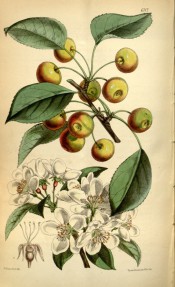Malus baccata (L.) Borkh var. sibirica C.K.Schneid
A small to medium sized tree of rounded habit, the leaves oval to lance-shaped, the flowers white, fragrant, borne in clusters. The fruit of the Siberian Crab is round, clustered, with yellow skin heavily streaked with red. To 15m or more. [RHSD, Hortus, Hilliers’]. See also See also Malus baccata (L.) Borkh. This is almost certainly the same plant.
Horticultural & Botanical History
‘This charming tree, though so long known in cultivation, has never before been well figured in this country. It has a very wide distribution; in Siberia it occurs in the eastern districts of Lake Baikal and in Dahuria; thence it passes by the Amur river north of China into Japan, whence we have numerous specimens. In the Himalaya it extends from the Indus to Kumaon, at elevations between 6000 and 11,000 feet, entering the Tibetan region of Piti; and it was gathered by Dr. Thomson and myself in the Moflong woods of the Khasia mountains, at an elevation of 6000 feet. It varies very much as to the pubescence of its parts; the Siberian and Japanese specimens being almost wholly glabrous; the Western Himalayan having more or less pubescent calyces, pedicels and petioles, and sometimes young leaves beneath; whilst those from the dry region of Piti, on the border of Tibet, are as glabrous as the Siberian; and those from the very wet region of the Khasia are the most pubescent of any. This correlation of humidity with pubescence is not unusual in the vegetable kingdom.’ [BM t.6112/1874].
The following edited notes on crab apples, including the Siberian Crab, which, according to Loudon was introduced to Britain as late as 1758, are from the ‘Herefordshire Pomona’.
‘(Crabs) are grown as much for their beauty in blossom and in fruit, as for their usefulness on the table, or in the sick room. They are so hardy and prolific, that they will flourish and bear fruit abundantly in cold, exposed situations, that would be fatal to most other cultivated apples. The hardiness of the Siberian Crab renders it a favourable fruit to use in hybridisation.
‘The fruit of almost all the varieties, when eaten fresh from the tree, has a peculiar taste, which renders it very refreshing during the hot weather of august or September. The beauty of these crabs often introduces them to the dessert table, either when newly gathered, or when preserved whole, as a rich and excellent sweetmeat. When simply boiled in a crust, they make a pudding of delicious aroma and taste. If eaten whole, however, whether in a fresh state, or cooked, the core and pips assert themselves so very prominently, that after boyhood, a very small allowance often suffices.
The juice, or pulp of the fruit, when prepared as a jelly, conserve or cheese, makes a rich and delicious sweetmeat, retaining the peculiar flavour so much esteemed, and in this form it usually makes its appearance on the dessert table. A refreshing drink for the sick room may be made by pouring boiling water over the cooked and broken fruit, and allowing it to cool.
When the trees are plentiful the fruit may also be used with apples to give a richness and flavour to the cider.’ [HP pl.LXXV/1878].
History at Camden Park
Listed in all printed catalogues [Apple no.18/1843].
Notes
Published Apr 15, 2010 - 04:19 PM | Last updated Aug 03, 2010 - 05:17 PM
| Family | Rosaceae |
|---|---|
| Category | |
| Region of origin | Siberia, Japan to Himalayas |
| Synonyms |
|
| Common Name | Siberian Crab, Cherry Apple, Cherry Crab, Red Siberian Crab, Scarlet Siberian Crab |
| Name in the Camden Park Record |
Siberian Crab |
| Confidence level | high |
